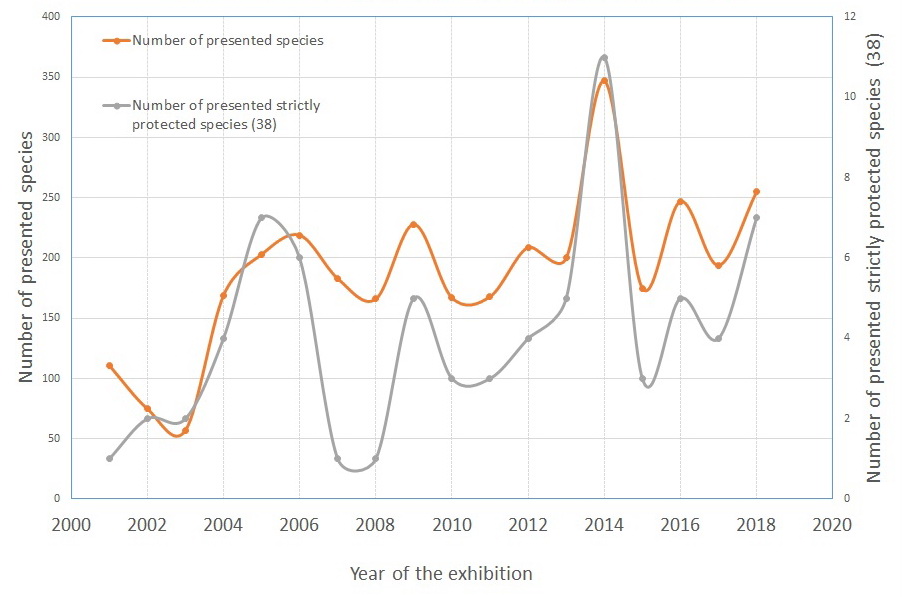Key message: The greatest number of mushroom species was in 2014
Assessment: The indicator shows trend of the appearance (number) of species and sporocarps (fruiting body) per species in the examined habitats. The change in the appearance frequency within long-term period indicates changes in habitats, environmental conditions, which affects health of forests, meadows and other fungi habitats. Upward population trend indicates that the ecosystem is stable and healthy. There have not been any significant changes of environmental conditions for a long time. Especially condition of the forest is strongly connected with condition of the present mycorrhizal fungi. Downward population trend indicates that there have been changes in environmental conditions and that the ecosystem is not stable anymore. Degradation of habitats leads to downward population trend of macrofungi.
Habitat protection of the rare macrofungi species, spreading of the forest areas, reducing of the chemical use in agriculture can lead to upward macrofungi population trend. Disappearance, degradation or fragmentation of habitats, especially forests (mycorrhizal fungi), pollution of the air, water and soil, climate changes, inadequate and excessive gathering of fruiting bodies for money or food, inevitably cause downward trends.

Indicator Name: Species diversity – Macromycetes (Macrofungi) population trend
Institution/Author: Sumadija mycological society (NGO), Kragujevac/dr Nebojša Lukić
Use and interpretation: The indicator shows the trend of the appearance (number) of species and sporocarps (fruiting body) per species on the examined habitats. The change in the appearance frequency within long-term period indicates changes in the habitats, environmental conditions, which affects the health of forests, meadows and other fungi habitats.
Key question(s) which indicator helps to answer
What is the population trend of macrofungi in the defined habitat? What is condition of the defined habitat?
Use of indicator
Macrofungi population trend is a valuable indicator of the ecosystem condition assessment.
Scale of appropriate use
For all macrofungi habitats.
Potential for aggregation:
Meaning of upward or downward trends (“good or bad”)
The upward population trend indicates that the ecosystem is stable and healthy. There have not been any significant changes of environmental conditions for a long time. Especially, the condition of the forest is strongly connected with the condition of the present mycorrhizal fungi.
Downward population trend indicates that there has been changes in environmental conditions and that the ecosystem is not stable anymore. Degradation of habitats leads to downward population trend of macrofungi.
Possible reasons for upward or downward trends:
Habitat protection of the rare macrofungi species, spreading of the forest areas, reducing of the chemical use in agriculture can lead to upward macrofungi population trend.
Disappearance, degradation or fragmentation of habitats, especially forests (mycorrhizal fungi), pollution of the air, water and soil, climate changes, inadequate and excessive gathering of fruiting bodies for money or food, inevitably causes downward trends.
Implications for biodiversity management of change in the indicator: Small number of macrofungi species is protected (26) and strictly protected (38) by Regulation on the declaration and protection of protected and strictly protected wild species of plants, animals and fungi rule book, Appendix 1 and 2 (Official Gazette of the Republic of Serbia, 5/2010), but the situation on the field indicates the need to revise and expand the defined number.
Units in which it is expressed: The number of sporocarps and species.
(e.g. km2, number of individuals, % change)
Description of source data:
Šumadija mycological society, Kragujevac
The field investigations were carried out frequently between 2001 and 2018. Population and diversity of Macrofungi were monitored and registered at numerous localities from Central, Western, and Southwestern parts of Serbia. Other parts were covered sporadically. Field data have been recorded systematically and samples of the rare and important species have been collected and studied in laboratory. Macrofungi occurrence frequency, time and place have been recorded for each identified species. Using those data, the Serbian check and red list of macrofungi have been formed. Some parts of the defined list (particular genus) have been published. Special occasions for collecting data are regular annual exhibitions of Serbian macrofungi at Faculty of Science, Kragujevac, organised by Sumadija mycological society. So far, eighteen (September) exhibitions of macrofungi have been held, since 2001. Lists of presented species are available on the society website (www.fungi-kg.org.rs).
(origins, dates, units, sample size and extent, custodians)
Calculation procedure:
According to sporocarps appearance, the eight frequency classes have been adopted: EC-extremely common; VC-very common; C-common; F-frequent; S-scarce; R-rare; VR-very rare and ER-extremely rare. In addition, the frequency classes are different depending of a terrain altitude. Two altitude classes have been considered: LA-lower altitude and HA-higher altitude.
The basic constraint for aggregation is weather conditions. The macrofungi appearance strongly depends on rainfall and humidity of substrate.
(include appropriate methods and constraints for aggregation)
Most effective forms of presentation: The best ways to present this indicator are tables and maps and they provide opportunity to monitor progress regarding this indicator and to record trends observed.
(graph types, maps, narratives, etc.-give examples where possible)
Limits to usefulness and accuracy: Slow change in the response and a small number of experts in this field.
(e.g. slow change in response to pressures, poor quality data, limited scope for updating):
Updating the indicator:
Investigations on the field should be carried out every year continuously over fungi appearance season. The surveys can be performed in 3-years intervals.
(How often? What is the process?):
Closely related indicators
Ecological conditions of the habitat, especially connected with a forest condition.
Additional information and comments
Macrofungi population trend represents a strong indicator for the assessment of terrestrial ecosystem conditions.